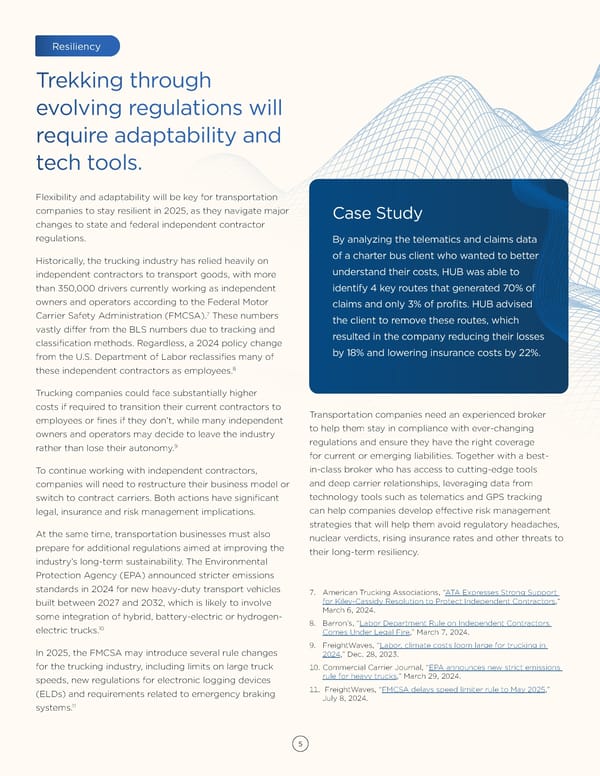Resiliency Trekking through evolving regulations will require adaptability and tech tools. Flexibility and adaptability will be key for transportation companies to stay resilient in 2025, as they navigate major Case Study changes to state and federal independent contractor regulations. By analyzing the telematics and claims data Historically, the trucking industry has relied heavily on of a charter bus client who wanted to better independent contractors to transport goods, with more understand their costs, HUB was able to than 350,000 drivers currently working as independent identify 4 key routes that generated 70% of owners and operators according to the Federal Motor claims and only 3% of profits. HUB advised 7 Carrier Safety Administration (FMCSA). These numbers the client to remove these routes, which vastly differ from the BLS numbers due to tracking and resulted in the company reducing their losses classification methods. Regardless, a 2024 policy change from the U.S. Department of Labor reclassifies many of by 18% and lowering insurance costs by 22%. 8 these independent contractors as employees. Trucking companies could face substantially higher costs if required to transition their current contractors to Transportation companies need an experienced broker employees or fines if they don’t, while many independent to help them stay in compliance with ever-changing owners and operators may decide to leave the industry regulations and ensure they have the right coverage 9 rather than lose their autonomy. for current or emerging liabilities. Together with a best- To continue working with independent contractors, in-class broker who has access to cutting-edge tools companies will need to restructure their business model or and deep carrier relationships, leveraging data from switch to contract carriers. Both actions have significant technology tools such as telematics and GPS tracking legal, insurance and risk management implications. can help companies develop effective risk management strategies that will help them avoid regulatory headaches, At the same time, transportation businesses must also nuclear verdicts, rising insurance rates and other threats to prepare for additional regulations aimed at improving the their long-term resiliency. industry’s long-term sustainability. The Environmental Protection Agency (EPA) announced stricter emissions standards in 2024 for new heavy-duty transport vehicles 7. American Trucking Associations, “ATA Expresses Strong Support built between 2027 and 2032, which is likely to involve for Kiley-Cassidy Resolution to Protect Independent Contractors,” some integration of hybrid, battery-electric or hydrogen- March 6, 2024. 10 8. Barron’s, “Labor Department Rule on Independent Contractors electric trucks. Comes Under Legal Fire,” March 7, 2024. In 2025, the FMCSA may introduce several rule changes 9. FreightWaves, “Labor, climate costs loom large for trucking in 2024,” Dec. 28, 2023. for the trucking industry, including limits on large truck 10. Commercial Carrier Journal, “EPA announces new strict emissions speeds, new regulations for electronic logging devices rule for heavy trucks,” March 29, 2024. (ELDs) and requirements related to emergency braking 11. FreightWaves, “FMCSA delays speed limiter rule to May 2025,” July 8, 2024. 11 systems. 5
 Steering the Future of Transportation in 2025 Page 4 Page 6
Steering the Future of Transportation in 2025 Page 4 Page 6